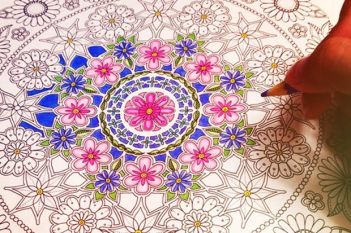Isn’t it a bit presumptous, not least to say arrogant, to declare that the book is dead? In an article by Adam Hammond entitled ‘Literature in the Digital Age‘ he refers to Katherine Hayle’s argument that “Nearly all human communication, from e-mail and text messages to phone calls and snail mail, is mediated through some form of digital code.” (Hammond 173) This fact cannot be denied, not even by a Luddite such as myself. However, this digital age should not be allowed to lead the debate on the validity of more ‘traditional forms of literary culture.’

The book in printed form out sold the e-book this year for the second year running, says the Guardian with a rise in children’s books and adult colouring books accounting for the majority of this increase.
As a parent of a teenager, I can testify to the popularity and preference of young people for print over electronic literature, as my daughter (13) asked for a new book at bedtime which I downloaded within minutes onto my Kindle and gave to her. I could not have attained the desired product with such immediacy if I had been relying on the book shop and print. A few days later she returned the Kindle and asked for the sequel with the proviso that it would come in printed form the next time. This dislike for the electronic book did not come from me I hasten to add. She said that it could not replace holding the product in her hands and turning the pages ‘properly.’

The Guardian suggests that children use books as ‘down time’ from their increasingly digital lives of social networking and gaming and as the first generation to have grown up in a completely digitized world it says something about the true nature of books if the next generation are turning to traditional modes of reading for relaxation.
Arguments for hypertext as a literary and empowering experience for the reader over the author, have no legitimacy. As Hammond’s article suggests, print is just as interactive and participatory as digital literature postulates, through the constructive discussions that take place in the classroom, in reading groups and in the varied formats of academic journals. It’s also important to note that the language of digital code has an author and everything in digital literature is constrained by the limitations of an author in some shape or form. We only see what the author wants us to see.
The ability that hypertext gives the reader to traverse multiple platforms during their reading experience is perhaps something that the linear printed experience cannot replicate as efficiently but, what digital literature fails to acknowledge, is that, “A word is not a static container for meaning, but rather a little apparatus that is not only marked by it’s own history as etymology but also by the reader’s personal experience with that word.” (Szilak 3) In other words, a word is many things to many people and it has a life past it’s digital construction. For Illya Szilak, in an article entitled “Towards Minor Literary Forms: Digital Literature and the Art of Failure” digital literature adds to our humanity, he argues for a co-cohabitant relationship between print and digital forms, exclaiming that both have a legitimacy and both are ‘art.’ It is to this end that I would have to agree.
![]()
Having interacted with the hypertextuality of ‘Pry‘, an e-literature which incorporates “Custom interactive gestures, audiovisuals, and psychological insights” (Jhave) I struggled to appreciate, what was surely a deeply intense and remarkable plot due to it’s overly ‘interactive’ nature. Jhave describes this ‘micro-drama’ and it’s gestures as “Playful, giddy, strange” serving more as a distraction than an enhancement of the plot. It is suggested that “It is difficult to allow entry into darkness if the door is a playground.” Perhaps that is what digital literature is to me. I only take my kids to the playground these days and I’m not sure I’d fit into the swings anymore.
Something that hypertext has also failed to engage with is the ‘bookishness’ of books. They are having something of a resurgence recently with regards to the aesthetics of a book culture. The battle between e-book and print has prompted booksellers to up their game somewhat and printed books can now be seen in the hands of celebrities and models and, in kitsch corners of the furniture market. Another article in the Guardian testifies to the lengths to which book shops are fighting back. Some are even employing technology to enhance the book buying experience.
Although I would openly admit that I am a lover of the traditional book in it’s leather bound, musty and tattered form, I can appreciate the innovations in technology to enhance the digital experience and make accessibility to literature a blessing rather than a curse. Yes, digital books are immediate, pushing the limits of the imagination and endeavouring to capture the nuances of a new digital generation but, even with the advancements of skemorphism, designed to reflect the traditional reading experience, the tangible product of the book cannot be replaced. The possession of an object of beauty and profound meaning which, is linked to our very humanity, regardless of age, gender or experience, is not quiet ready for it’s demise just yet. Long live the book bound book!
